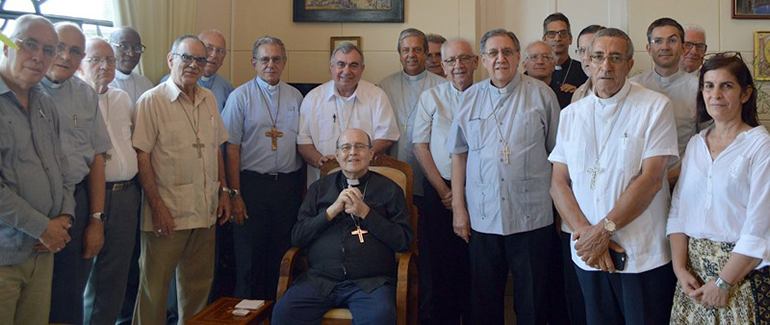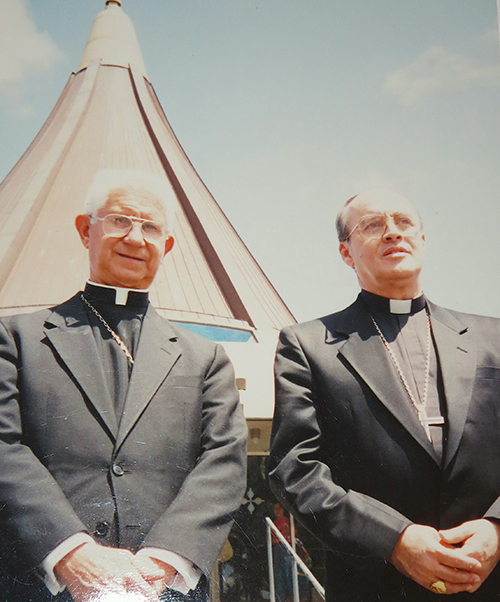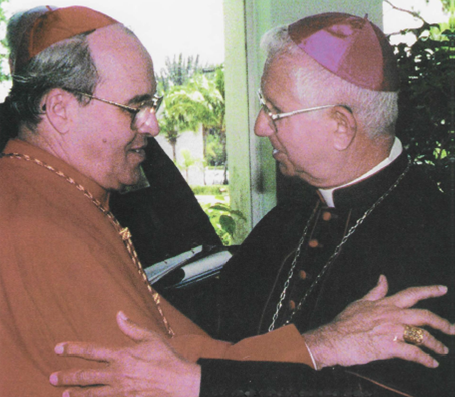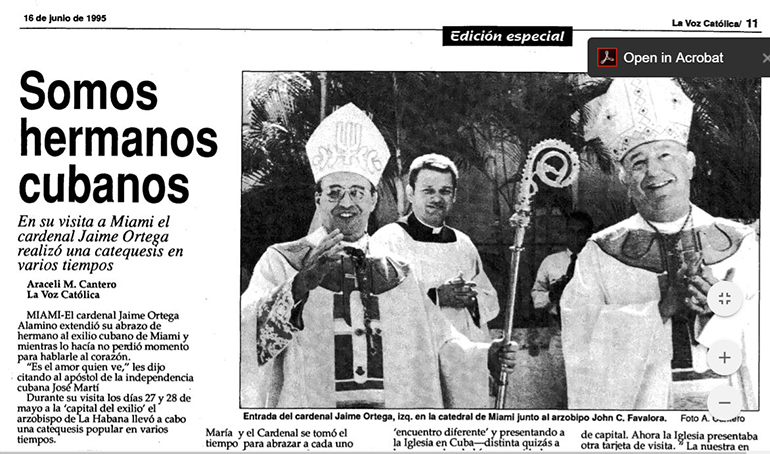By Ana Rodriguez Soto - The Archdiocese of Miami

Photographer: COURTESY | Raul Panellas
In his last public appearance, Cardinal Jaime Ortega, seated and surrounded by his fellow Cuban bishops, receives the Mons. Carlos Manuel de Céspedes Distinction from the Commission on Culture of the Cuban bishops' conference. Conferred June 12, the distinction recognizes Catholic personalities and institutions that, inspired by Christian faith, conduct notable work aimed at evangelizing the culture.
MIAMI | In exile political circles, he was controversial. But exiled Cuban Catholics who knew and worked with Cardinal Jaime Ortega take a different view.
“I had beautiful experiences of friendship with him and I feel an extraordinary fondness and even greater admiration for his person and everything he has meant for our Church,” said Ondina Menocal, speaking with La Voz Católica, the Spanish-language archdiocesan newspaper.
She described Cardinal Ortega as “an excellent Catholic and Cuban,” words also used by Archbishop Thomas Wenski in interviews with local media: “a dedicated man of the Church and an exemplary Cuban.”
Cardinal Ortega died July 26 in Havana due to cancer. He was 82 and had been a priest for 55 years, including 40 as bishop; 34 of those he was archbishop of Havana, 24 of them as cardinal. He first led the diocese of Pinar del Río from 1978 to 1981.
Born Oct. 18, 1936 in Jagüey Grande, in the province of Matanzas, he was ordained a priest in 1964. In 1966, he spent eight months in a Cuban government “re-education camp,” after which he had permission to leave the island. But “he chose to stay,” said architect Orlando Márquez, who started the magazine “Palabra Nueva” (New Word) for the Archdiocese of Havana in 1992 and served as its editor until 2016.
In an interview with Holguín Católico, Márquez said he considers Havana “the most complicated see for a Cuban bishop,” adding, “He was the right person at the right time.”
CARITAS AND A SEMINARY
Havana attorney Rolando (Piro) Suárez confirmed that in another interview with Holguín Católico. Cardinal Ortega created Caritas in the Archdiocese of Havana in 1991. It became Caritas Cuba, reaching the whole island, a year later, with Suárez becoming island-wide director in 1993. Until that time, the Cuban government had not permitted such independent social service organizations, but after the fall of the Soviet Union in January 1990, and the end of its massive subsidies to the island, the need arose for a charitable branch of the Church.
Suárez praised the intense pastoral work of Archbishop Ortega during those years, spurring the laity to action, reorganizing the diocesan offices, and creating numerous services. “Cardinal Ortega’s efforts and effective pastoral work, along with the visits of three popes to Cuba, modified and marked Cuba’s reality during this period,” Suárez said.
Cardinal Ortega also obtained the government’s permission to build a new seminary for the Cuban Church — along with the funds for its construction, including large donations from the Knights of Columbus and U.S. bishops.
His commitment to Cuba and its people led him to support migration agreements that favored the unification of Cuban families, to intercede for the liberation of political prisoners, and to push for greater understanding between the Cuban and U.S. governments.
Menocal is one of the so-called “historic exiles” who arrived in the first waves, during the 1960s and 1970s. Her involvement in Hispanic pastoral ministries in the Archdiocese of Miami spans decades, and she also serves as coordinator of Hispanic apostolic movements.

Photographer: COURTESY | Araceli Cantero
File photo of Cardinal Jaime Ortega, left, with Miami Auxiliary Bishop Agustín Román during the cardinal's visit to Miami in 1995.

Cardinal Jaime Ortega, left, embraces Miami's then Auxiliary Bishop Agustín Román during the Cuban prelate's visit to the National Shrine of Our Lady in Miami the spiritual center of Cuban exile.
She said she first met Cardinal Ortega through Miami’s beloved Auxiliary Bishop Agustín Román, the longtime rector of the spiritual center of Cuban exile, the National Shrine of Our Lady of Charity. It was 1990, and he traveled to Miami to concelebrate the funeral Mass for his predecessor, Havana Archbishop Ricardo Oves. The Mass was celebrated in St. Mary Cathedral.
Menocal said she witnessed “the admiration and respect Bishop Román always manifested for him.”
Cardinal Ortega also came to Miami in 1995, shortly after being named a cardinal, making stops at the cathedral, the Shrine of Our Lady of Charity and St. Thomas University.
“I don’t feel there’s any justification for there being any type of controversy around him,” Menocal said. “There’s not a single word in his expressions that does not demonstrate a truly Christian person,” she added, alluding to the book that contains nearly all his talks and homilies. The book bears the title of his episcopal motto, “Te Basta Mi Gracia” (My Grace Is Enough).
‘EXTRAORDINARY SON’
During the 1990s, Menocal began traveling to Cuba to learn for herself about the situation of the Cuban Church and to build ties of friendship and cooperation with priests and laity there. Whenever she went, she would visit the cardinal’s mother.
“He was an extraordinary son,” Menocal said, “but he also was a person of such goodness, of such sensibility, of such spirituality,” who expressed himself “very poetically, very delicately.”
Morever, she said, the cardinal could identify with the Cubans in exile because “for him, being Cuban and living outside of Cuba was the worst thing that could happen.”
She recognizes that the cardinal lived in very difficult times, “and those who want to harm the Church criticize him.” But it’s important to understand that he was dealing with a totalitarian regime.
“Jaime’s message was a message of love. The message of those people (the communists) was a message of hate,” Menocal said.
Father Juan Sosa, pastor of St. Joseph Church on Miami Beach, also got to know and work closely with Cardinal Ortega. “Decidedly, the exiles who are not deeply familiar with the vicissitudes of Cuba’s poor Church should neither criticize nor abuse of his presence in history,” he said.
‘MAINTAINING A BALANCE’
The cardinal, working with the Cuban bishops’ conference, managed to arrange the “impressive” visit of Pope John Paul II to the island in 1998. “Because of that, the Church began to gain spaces and opportunities that had been suppressed since the 1960s,” Father Sosa said.
“He sought to maintain the balance between the Church and the government from a firm posture of faith, despite having his interventions discussed and frequently criticized inside and outside the island,” the priest added.
Father Sosa arrived in Miami at the start of the 1960s, as one of the 14,000 unaccompanied minors who were sent out of Cuba under the Church-run Operation Pedro Pan. He would return to Cuba for the first time 23 years later, as part of an effort to begin collaborating with the laity and clergy on the island, referred to back then as “the silent Church.”
He has returned many times since then, not only for the visits of popes John Paul II, Benedict XVI and Francis, but also to teach courses on liturgy alongside Rogelio Zelada, associate director for Hispanic formation in the Archdiocese of Miami’s Office of Lay Ministry.
The arrangements for their first course were made by the cardinal himself.
“More than 100 people from all the parishes attended all the sessions we taught,” Father Sosa recalled. “They came from every corner, something that required a lot of sacrifice. We were the first Miami professors permitted to teach a course. The cardinal always encouraged efforts to educate the population and continue the formation of the clergy.”
Father Sosa said he would remember Cardinal Ortega as a “kind, smiling man, a lover of good music and a composer,” who “knew how to maintain the dignity of the cardinalate projected earlier by Cuba’s first cardinal, (Manuel) Arteaga. And at the same time, he never stopped proclaiming the Good News of Jesus with the insistence that the people yearned to hear.”
Araceli Cantero, former editor of La Voz Católica and now a freelance writer, contributed to this story.
This article was amended to correct the title of Cardinal Jaime Ortega's book and episcopal motto, "Te Basta Mi Gracia." The number of years he was bishop, archbishop of Havana and cardinal also has been corrected; as well as the dates of the establishment of Caritas Cuba.


